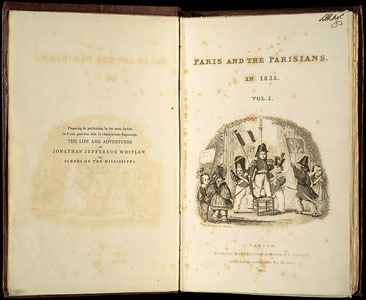| UCLA Library Special Collections |
 |
The Grand
Tour, an eighteenth-century institution for the education
of young gentlemen, made travel in Europe something of a known
quantity. Mme de Staël, Lady Blessington and Frances
Trollope all visited cities that were part of the classic
tour: Paris, Rome, Naples (with side-trips to Pompeii and
Vesuvius), Berlin and Dresden. Travel to these centers, however,
across the Alps and through the French and Italian countryside
(usually by diligence), was slow and uncomfortable; accommodation
was often rough. Women generally
began with Europe, where they increased their knowledge
and skills for the greater challenges of travel to other
continents.
|


|

Mary Wollstonecraft.
Letters Written during a Short Residence in Sweden,
Norway, and Denmark. London: J. Johnson, 1796. |
Mary Wollstonecraft
(1759-1797)
The feminist author of A Vindication
of the Rights of Women traveled to the Continent in
1792 to observe and write about the French Revolution. There
she met, and had a child by, Gilbert Imlay, an American
entrepreneur and ex-officer in the revolutionary army. Imlay,
probably hoping to get her out of the way, sent Wollstonecraft
to Scandinavia – bleak, primitive and little-traveled
in the eighteenth century. Letters, her one travel
book, describes her journey (with her one year-old daughter
and nursemaid) through this forbidding landscape.
|
Frances Trollope
(1730-1863)
When her barrister husband’s
fortunes fell, and the family lost house and belongings,
Mrs. Trollope (mother of Anthony) took it upon herself to
provide for her seven children by writing travel books.
Over the course of a decade, she visited five countries
- the United States, Belgium, Austria, France, and Italy
– and produced a book about each of them. Her greatest
success was actually her first book, the controversial Domestic
Manners of the Americans (1832). |

Frances Trollope.
Paris and the Parisians in 1835. London: R. Bentley,
1836. 2 volumes. |
|

|
Madame de Staël
(1766-1817)
Mme de Staël, the spirited intellectual
of Paris salon fame, was forced to travel by the French
Revolution. She lived as an emigrée |
Corinne
où l’Italie. London: Peltier, 1807.

The most famous nineteenth-century
novel about Rome. Corinne is often described
as a travel book that poses as a novel.
|
at
her estate in Geneva, but traveled to Italy and Germany. Later,
hounded by Napoleon’s police, she fled to Russia and
England. In addition to Corinne, she wrote two other
important travel books: Dix années d’exil
and De l’Allemagne. Her Geneva home was a popular
tourist destination. Lady Blessington, author of The Idler
in Italy, was one of those who visited her there.
|
| 
The Idler in
Italy. London: Henry Colburn, 1839-40.
3 vols. |
Lady Marguerite
Blessington (1789-1849)
The glamorous Countess Blessington
titillated London society with her liaisons dangereuses
(most particularly, a grande affaire with her stepdaughter’s
husband the Comte d’Orsay). Bored with London, she
“idled” for ten years in France and Italy. Her
romantic descriptions of easy travel among the monuments
and ruins of Paris and Pompeii made continental travel a
“coveted accomplishment … suave, a little risqué,
and utterly fashionable,” for women of quality. (Robinson,
Wayward Women)
|

wilder
shores exhibit home |
europe
| russia
| turkey
| the
middle east | india
and the far east | africa
| the
americas | credits
©
2007 by the Regents of the University of California. All rights
reserved. |
|
Wilder
Shores is organized geographically, loosely following the structure
of Barbara Hodgson’s book No Place for a Lady: Tales of Adventurous
Women Travelers. (Berkeley: Ten Speed Press, 2002). The exhibit features
books and manuscripts, both by and about, women who traveled to these
regions:
|









